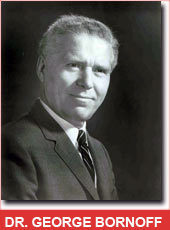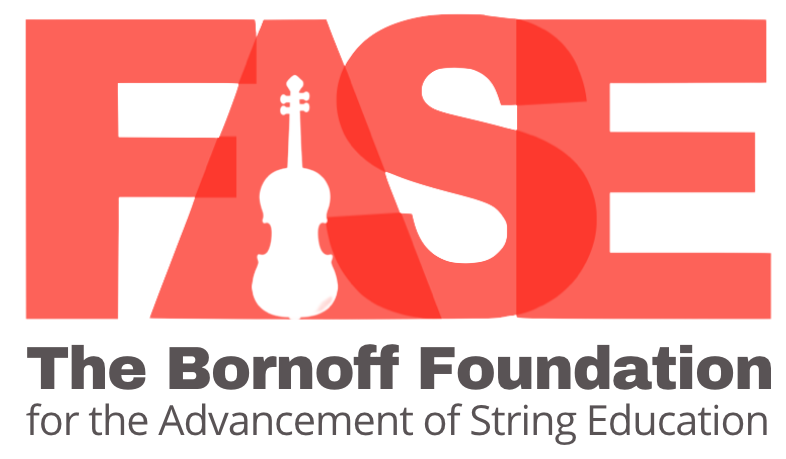About dR.Bornoff
“What is seen in Bornoff’s published books is just the tip of the iceberg.”
– Duffie Adelson, Merit School of Music
 Violinist ~ Pedagogue ~ Visionary
Violinist ~ Pedagogue ~ Visionary
1907- 1998
Born in Winnipeg, Canada in 1907 as the eldest child of Russian immigrants, Dr. George Bornoff began his violin studies at the age of five. By the age of thirteen, young George had started teaching, and by the age of sixteen, he was a serious solo and orchestral performer in western Canada. Winnipeg in the 1920s and 1930s was the major stop for all cross-Canada railroad transportation. This meant that the famous touring violinists of the day, such as Fritz Kreisler and Jascha Heifetz, all had to stop in Winnipeg as part of their eastward or westward travels, making the city a natural concert stop. The manager of the local concert hall was a buddy of the young Mr. Bornoff, and often arranged not only optimal seating for critical observation, but private discussion and instruction with these great violinists following their performances.
George Bornoff was precocious―as a violinist and as a teacher. His interests and studies were varied and he could well have decided on a career in hockey, theology, or mathematics. Instead, each of these domains prepared him for the creative work he would do in developing his unique system of string education. He often said, “I have invented nothing. I have merely re-organized the presentation of materials.” As with so many things in life, the genius is in the packaging. This genius was expressed as he created and refined his system while founder and head of the Bornoff School of Music in Winnipeg. In 1943 he moved to New York to pursue a Master of Arts at Columbia University’s Teachers College. Completing his degree work after just one year, he soon joined the faculty as head of String Development and Chamber Music. While at Columbia, he formalized and published his work, and began sharing it with other teachers throughout the area. In 1953 he became Professor of Music Education at Boston University. By this time his workshops and Bornoff-oriented programs were being established around the continent. After his retirement from Boston University in 1970, Dr. Bornoff continued his interest and efforts in the field, helping initiate string programs and develop young teachers in the Boston area.
When Dr. Bornoff established FASE, Inc. in 1978, he conceived it primarily as a vehicle for teaching teachers how to apply the principles and use the materials he had developed over fifty years as one of the leading figures in the world of string education. Even though he clearly was an out-front kind of person, he was also a mover and shaker from behind the scenes. Dr. Bornoff often said, “The greatest thing you can do for a person is to help him be right.” That is what he endeavored to do: to give string teachers the skills, materials and support they needed to produce outstanding results in their work. He did so boldly with conviction, as well as quietly with an endurance that spanned the careers of many teachers. Dr. Bornoff never ceased refining his own teaching philosophy, approach and skills as a teacher and continued training other string teachers until his passing in 1998 at the age of 91.
I have used and researched other methods in my teaching, but I always come back to Bornoff. There is no other method that gives students these skills so quickly and efficiently. The flexibility of the fingers of the left hand is constantly reinforced through the patterns and the variety of bow strokes not only gives the student a solid basis for later, more complicated, skills, but also creates a more interesting palate for practicing.
– Lisa Lanzkron-Tamarzo
First formalized and published in the 1950s, Dr. Bornoff’s classroom approach still holds tremendous value for today’s string teacher. Believing that every child has not only the ability, but the right to learn a string instrument, Dr. Bornoff created a finely-tuned classroom approach which can develop conservatory-level proficiency without traditional private lessons.
Extensive discussion with great artists and teachers of his time – Fritz Kreisler, Mischa Elman, Jascha Heifetz, Gary Karr, Marvin Rabin, to name a few – left George Bornoff “determined that it is absolutely essential to teach students artistry in playing as well as technique – and the sooner the better!” His approach skillfully sequences and integrates bowing technique, fingering, positions, shifting, double stops, harmonics, vibrato and more, and through the use of meaningful repetition, nurtures emotional maturity, and creative and technical flexibility, firmly grounded with sonorous tone production and artistic phrasing.
Today, the Foundation for the Advancement of String Education, Inc. continues the work of Dr. George Bornoff, focusing mainly on string teacher grants and training to advance the teaching of strings in school music programs. For more information about this teacher of teachers, and an introduction to his masterful approach, read Bornoff: Breakthrough for String Education, available for purchase on the Publications Page.
George Bornoff’s unique contribution to string pedagogy was to make use of fingering patterns that enable students to play a one-string melody on each of the four strings thereby introducing the student to the tonal richness of the entire instrument. The technique requires the player to learn bow arm levels for each string which, when introduced at a young age, is easily grasped. Children love learning to play on all of the strings. The method lends interest and excitement to the simple early songs so important in beginning string classes.“
– Doris Gazda
